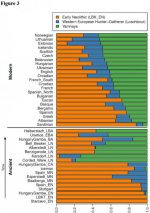Sile
Banned
- Messages
- 5,110
- Reaction score
- 582
- Points
- 0
- Location
- Australia
- Ethnic group
- North Alpine Italian
- Y-DNA haplogroup
- T1a2 -Z19945..Jura
- mtDNA haplogroup
- H95a1 ..Pannoni
As to how he got to Iberia, I have some doubt that this individual, even if it's proved that he has a "Yamnaya" kind of autosomal signature, would have ridden a horse from the steppe across a mostly forest covered European landscape at a time when the horse hadn't even been domesticated yet, or was just being domesticated (see Anthony for a date about 3500 BC), and the later Corded Ware people still often used oxen to pull their primitive carts. Not to mention the fact that they would have had no reason to go due west on the European landmass to Iberia, leaving no trace of their passage in the Copper Age cultures of central Europe.
agree with you on the horse
there is also some issues with Haak R1b-V88 in Spain
an interesting post
http://dispatchesfromturtleisland.bl...na-doesnt.html
The H2, as discussed further below, is rare but has a generally West Eurasian non-hunter-gatherer distribution.
What About The Man From El Trocs Cave?
This said, there is one chink in this argument. In a 2015 paper by Haak et al., that reports 69 ancient DNA results from Europe, there is a reference to a man from Neolithic Spain ca. 5100 BCE whose body was found in the El Trocs cave in the Pyrenees Mountains in Northern Aragon whose Y-DNA haplogroup was found to be R1b1* ancestral to all extant forms of Y-DNA R1b (both V-88 from Africa and the Eurasian haplogroups; he is not R1b-V88 as has been frequently misreported). This long predates Bell Beaker and coincides with the very early Neolithic era in the region, and is also not far from modern Basque country.
IF not V88 , then another R1b from earlier than ATP3 in Iberia.


